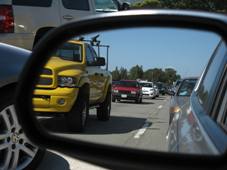
Today the federal Environmental Protection Agency formally granted the waiver that California has sought since 2002, allowing the state to set its own standards for greenhouse gas emissions from cars.
But wait–didn’t this already happen for practical purposes, last month? That’s when the Obama administration announced its intent to essentially put California’s proposed standards in place nationwide.
Well, yes–and no. Bernadette Del Chiaro, who represents the group Environment California, says that having the waiver is more than a legal technicality. She says it means that the state can get started sooner, cleaning up tailpipe emissions. Del Chiaro explains that: “California’s standards kick in now, through 2016. The federal program that President Obama has extended throughout the entire country, starts in 2013 (also through 2016).”
That gives the states, in effect, a three-year jump-start. In 2013, everybody should be on the same page.
California’s chief air regulator, Mary Nichols said, in a written statement:
“The waiver affirms California’s authority to set the standards for the cleanest cars in the nation and recognizes the ability of forward-thinking states to continue to adopt them. Now we can begin to work with the manufacturers to make a new generation of cars that deliver all the comfort and power we have come to expect but with improved efficiency and far fewer greenhouse gas emissions. ”
Thirteen other states had also pursued the waiver and can now proceed with their own programs.
While automakers have long argued that the tighter regs will make cars more expensive, Environment California calculates that they’ll “save consumers $36 billion at the pump by 2020.” That projection assumed that gasoline would would average about $2 per gallon over that period. Higher pump prices (which seem a lot more likely) would in turn, increase expected savings, as the underlying premise is that we’ll be driving cars that get better gas mileage.
But of course those cars will cost more than the clunkers we’re wheeling around in now. The state Air Resources Board estimates that the clean car regulations will tack an average of $1,000 onto the price of a new car by 2016. Obviously that would offset some of the pump savings.
4 thoughts on “California’s EPA Waiver: Does it Still Matter?”
Comments are closed.

I’m afraid this article provides misinformation regarading the importance of the EPA waiver to California.
When the Obama Administration announced the federal plans to increase fuel economy to 35.5 MPG (30 MPG for trucks, 39 MPG for passenger cars) by 2016, California and all states currently adopting the California standarsd agreed to defer to the federal standards if granted a waiver by the EPA. This means that there is one national standard through model year 2016, even if California gets its waiver (which it did).
However, the California standards includes a second phase of reductions that will phase in after 2016. These are referred to as the Pavley Phase II standards. This is why it was still important for California to obtain the waiver. The Phase II standards are a key strategy for the state to achieve the reductions necessary to meet AB 32.
This article is incorrect in that California will not be able to “jump start” the reductions. California will still follow the federal path up until 2016, after which time, California will be able to implement the Phase II standards achieving even greater CO2 reductions so that the state can meet 1990 levels by 2020.
California’s leadership in reducing global warming pollution and spurring technological innovation is illustrated once again with the Obama Administration’s final granting of the Clean Cars Waiver. The previous writer is perhaps splitting hairs over semantics or is simply wrong.
Under the agreement reached between California and the Obama Administration, and then reinforced by the actual granting of the waiver, California and the other states adopting California’s clean cars standards can start reducing CO2 emission from tailpipes immediately instead of waiting until 2013 when the federal standards kick in. At that point, the previous writer is correct, the federal standards will, mostly by default, take affect in California and everywhere else.
As for Pavley II, this is the next phase and one that has yet to be developed. It, along with a revision to the Zero Emission Vechicle program and the Low Emission Vehicle program, also administered by CARB, are the next policy drivers of clean cars in America.
This is just another example of stupid politics in action. The car companies are already bankrupt, so these self centered egotists add yet another layer of bureauracracy to building cars, and for what? Just so they can say they did it, while China and India spew out CO2 like there is no tomorrow? This is a waste. There should be one national standard, and that’s it. CARB now represents everything that is wrong with California, inefficient and wasteful. They served a purpose at one time, but their time is over, as is pretty obvious when they try to regulate paint reflectivity. I see nothing useful coming out of CARB anymore. They should let the EPA do the job, shut CARB down, and save the taxpayers the money on these bloated, egregious bureaucrat’s salaries and benefits.